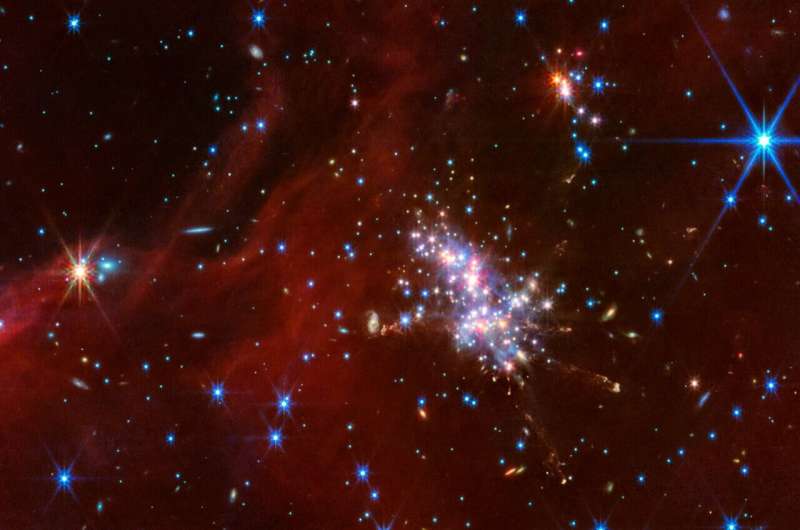Astronomers have directed NASA’s James Webb Space Telescope to examine the outskirts of our Milky Way galaxy. Scientists call this region the Extreme Outer Galaxy due to its location more than 58,000 light-years away from the Galactic Center. (For comparison, Earth is approximately 26,000 light-years from the center.)
A team of scientists used Webb’s NIRCam (Near-Infrared Camera) and MIRI (Mid-Infrared Instrument) to image select regions within two molecular clouds known as Digel Clouds 1 and 2. With its high degree of sensitivity and sharp resolution, the Webb data resolved these areas, which are hosts to star clusters undergoing bursts of star formation, in unprecedented detail. Details of this data include components of the clusters such as very young (Class 0) protostars, outflows and jets, and distinctive nebular structures.
These findings have been published in the Astronomical Journal.
These Webb observations, which came from telescope time allocated to Mike Ressler of NASA’s Jet Propulsion Laboratory in California, are enabling scientists to study star formation in the outer Milky Way in the same depth of detail as observations of star formation in our own solar neighborhood.
“In the past, we knew about these star forming regions but were not able to delve into their properties,” said Natsuko Izumi of Gifu University and the National Astronomical Observatory of Japan, lead author of the study.
“The Webb data builds upon what we have incrementally gathered over the years from prior observations with different telescopes and observatories. We can get very powerful and impressive images of these clouds with Webb. In the case of Digel Cloud 2, I did not expect to see such active star formation and spectacular jets.”
Stars in the making
Although the Digel Clouds are within our galaxy, they are relatively poor in elements heavier than hydrogen and helium. This composition makes them similar to dwarf galaxies and our own Milky Way in its early history. Therefore, the team took the opportunity to use Webb to capture the activity occurring in four clusters of young stars within Digel Clouds 1 and 2: 1A, 1B, 2N, and 2S.
For Cloud 2S, Webb captured the main cluster containing young, newly formed stars. This dense area is quite active as several stars are emitting extended jets of material along their poles. Additionally, while scientists previously suspected a sub-cluster might be present within the cloud, Webb’s imaging capabilities confirmed its existence for the first time.
“We know from studying other nearby star-forming regions that as stars form during their early life phase, they start emitting jets of material at their poles,” said Ressler, second author of the study and principal investigator of the observing program.
“What was fascinating and astounding to me from the Webb data is that there are multiple jets shooting out in all different directions from this cluster of stars. It’s a little bit like a firecracker, where you see things shooting this way and that.”
The saga of stars
The Webb imagery skims the surface of the Extreme Outer Galaxy and the Digel Clouds, and is just a starting point for the team. They intend to revisit this outpost in the Milky Way to find answers to a variety of current mysteries, including the relative abundance of stars of various masses within Extreme Outer Galaxy star clusters. This measurement can help astronomers understand how a particular environment can influence different types of stars during their formation.
“I’m interested in continuing to study how star formation is occurring in these regions. By combining data from different observatories and telescopes, we can examine each stage in the evolution process,” said Izumi.
“We also plan to investigate circumstellar disks within the Extreme Outer Galaxy. We still don’t know why their lifetimes are shorter than in star-forming regions much closer to us. And of course, I’d like to understand the kinematics of the jets we detected in Cloud 2S.”
Though the story of star formation is complex and some chapters are still shrouded in mystery, Webb is gathering clues and helping astronomers unravel this intricate tale.
More information:
Natsuko Izumi et al, Overview Results of JWST Observations of Star-forming Clusters in the Extreme Outer Galaxy, The Astronomical Journal (2024). DOI: 10.3847/1538-3881/ad4e2e
Citation:
Webb peers into the Extreme Outer Galaxy (2024, September 12)
retrieved 15 September 2024
from https://phys.org/news/2024-09-webb-peers-extreme-outer-galaxy.html
This document is subject to copyright. Apart from any fair dealing for the purpose of private study or research, no
part may be reproduced without the written permission. The content is provided for information purposes only.

